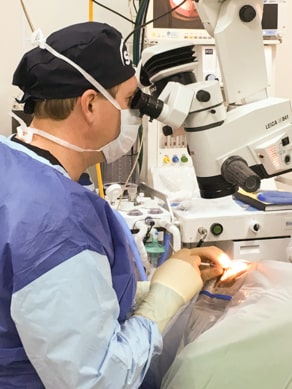Glaucoma Surgery
People frequently ask, is there a surgery for glaucoma? Glaucoma surgery is an option that can help lower the intraocular pressure in your eye when medication is not able to do so. However, it cannot reverse vision loss experienced by a glaucoma diagnosis.
Glaucoma surgery options may include laser surgery, incisional surgery or other microsurgery options. Traditional glaucoma surgeries, while very effective can be associated with risks such as double vision, eye infections, swelling of the cornea, and excessively low intraocular pressure. It’s important that your glaucoma specialist is aware of all other conditions and personally speaks with you to determine the correct treatment for your condition.
Types of Glaucoma Surgery
Laser Eye Surgery For Glaucoma
Laser surgeries have become important in the treatment of different eye problems and diseases. Laser eye surgery for glaucoma increases the outflow of fluid from the eye in open-angle glaucoma or eliminates the fluid blockage in closed-angle glaucoma. There are several types of laser surgery that can be used:
Selective Laser Trabeculoplasty
Selective Laser Trabeculoplasty is used to treat open-angle glaucoma. This procedure uses a laser that works at very low energy levels. It treats specific cells “selectively,” leaving the overall structure and architecture of the trabecular meshwork intact. Selective laser trabeculoplasty can be repeated if needed. This surgery has successfully lowered eye pressure in up to 70% of patients treated.
Laser Peripheral Iridotomy
Laser Peripheral Iridotomy is used to treat closed-angle glaucoma. Closed-angle or narrow-angle glaucoma occurs when the angle between the iris and the cornea is too small. This causes the iris to block fluid drainage, increasing inner eye pressure. Laser peripheral iridotomy procedures make a small hole in the iris, allowing it to fall back from the fluid channel and helping the fluid drain.
Minimally Invasive Glaucoma Surgery (MIGS)
 Minimally invasive glaucoma surgery (MIGS) is a group of operations that work by using microscopic-sized equipment and tiny incisions to provide increased safety. MIGS typically requires shorter operation time and allows for more rapid visual recovery. Although no surgery is without risk, MIGS has grown in popularity among eye surgeons in recent years for the improvements in safety. The tradeoff that comes with lower risk for complications is that we typically see more mild to moderate reductions in intraocular pressure with this type of procedure. Thus, it is unlikely to completely replace traditional glaucoma surgery, particularly in cases of advanced disease or high pressure that needs more aggressive lowering. It does give us additional options to consider for customizing the treatment to the individual.
Minimally invasive glaucoma surgery (MIGS) is a group of operations that work by using microscopic-sized equipment and tiny incisions to provide increased safety. MIGS typically requires shorter operation time and allows for more rapid visual recovery. Although no surgery is without risk, MIGS has grown in popularity among eye surgeons in recent years for the improvements in safety. The tradeoff that comes with lower risk for complications is that we typically see more mild to moderate reductions in intraocular pressure with this type of procedure. Thus, it is unlikely to completely replace traditional glaucoma surgery, particularly in cases of advanced disease or high pressure that needs more aggressive lowering. It does give us additional options to consider for customizing the treatment to the individual.
Are you a candidate for Minimally Invasive Glaucoma Surgery (MIGS)?
Incisional glaucoma surgery is usually restricted to patients with glaucoma that is out of control and getting progressively worse despite aggressive medication regimens. However, the improved safety profile with MIGS allows us to consider surgical treatment of glaucoma earlier in the course of the disease, and in some cases, it can even be used to decrease medications for controlled glaucoma where the medication regimen is burdensome or costly to the patient. MIGS procedures are commonly performed in conjunction with cataract surgery, and in some cases are only FDA approved to be completed as such. Other examples of MIGS can be performed as a procedure for glaucoma independent of cataract surgery.
Filtering Surgery for Glaucoma
When other treatments do not lower eye pressure adequately, your doctor may recommend filtering surgery. In filtering surgery, a tiny drainage hole is made in the sclera, the white part of the eye. The new drainage hole allows fluid to flow out of the eye and helps lower eye pressure. Sometimes a small tube is used to help ensure the opening stays patent long term. This can prevent damage and help to protect the optic nerve. The surgery is usually done with a local anesthetic, relaxing medications and a limited type of anesthesia called intravenous sedation. Usually filtering surgery is an outpatient procedure, requiring no overnight hospital stay.
Recovering from Glaucoma Surgery
People often ask, “How long does it take to recover from glaucoma surgery”? Recovery from glaucoma surgery will typically be longer than other more common eye surgeries, such as cataract or LASIK surgery. Your glaucoma specialist will discuss the expected recovery with you based upon the procedure they recommend for your situation. Glaucoma surgery is not typically painful, but most patients describe a sore or scratchy feeling during the early recovery period. Most will find relief with use of artificial tears, cool compresses, or over the counter pain medicine.
Trust the Glaucoma Experts at Wolfe Eye Clinic
Wolfe Eye Clinic offers complete glaucoma treatment services throughout Iowa, including Ames, Cedar Falls, Cedar Rapids, Des Moines, Marshalltown, Ottumwa, Pleasant Hill, and Waterloo. Our glaucoma specialists can provide options for treatment, management and surgery depending on your glaucoma type and personal vision circumstances.
Interested in more information on Glaucoma? Request information or contact Wolfe Eye Clinic at (833) 474-5850 to schedule an appointment with one of our glaucoma specialists: Dr. Gregory Christiansen, Dr. Benjamin Mason, or Dr. Ryan Vincent.